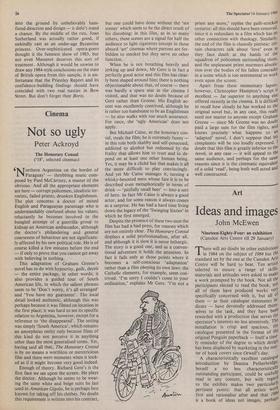Art
Ideas and images
John McEwen
There will no doubt be other exhibitions in 1984 on the subject of 1984 but the standard set by the one at the Camden Arts Centre will be hard to beat. Ten artists selected to ensure a range of skills, materials and attitudes were asked to make a work prompted by the book. Not all the participants elected to read the book, not all of them have produced works very specifically concerned with it, but all 01 i them — as their catalogue statements n- dicate — have devotedly addressed the selves to the task, and they have been rewarded with a production that serves the spectator's interests no less attentively. The installation is crisp and spacious, the catalogue presented in the format of the original Penguin paperback — itself a thne- ly reminder of the degree to which design has been displaced by marketing in the mat' ter of book covers since Orwell's day. A characteristically excellent catalogue introduction by Deanna Petherbridge' herself a no less characteristicallY outstanding participant, could be usefully read in any context, but with regard to the exhibits makes two particularly pertinent points: that all artists. work first and rationalise after and that 19° is a book of ideas not images, perhaps deliberately 'to enforce the bleakness of the message'. Written reactions to the book, in the form of the artists' catalogue state- ments, accordingly prove more interesting than the visual objects to which they give. rise, the most notable exception being Paula Rego's. Her immense 'Proles Wall' — 40 ft long and 8 ft high — succeeds in being both spontaneous and unified, an extraordinary achievement. It is this unification that signals it as an advance in her own work, her last efforts in this supremely free style like an off-the-cuff story drawn in a sketchbook, out of the inkwell, as it were, and onto the page — being a series of separate images devoted in each case to a famous opera. They were on large sheets of Paper tacked to the wall. Now she has employed the same technique in acrylic Paint on softboard, ten panels painted two at a time and joined to form a single strip. saps left by large figures are busily filled with little ones, these smaller elements of the line drawing often set in bands of grey or red, which act as the struts of a new and beneficially unifying order. The painting became a diary of her own life, as she puts It, 'echoing Winston's diary' in the book, Wall' personal animation raising 'Proles wall' far above illustration. Unlike the English contributors to the exhibition, Paula Rego, being Portuguese, has first- hand experience of dictatorship, 'of news so heavily censored that there was nothing left except football and folklore'. Her folklore method, in which characters tend
to be depicted as animals, thus lends a final, ironic, twist to the interpretation.
Less overwhelming but little less memorable are Deanna Petherbridge's ink and wash drawings which, no less characteristically, exemplify a Piranesian taste for drawing architectural fantasies as metaphors of her own feeling. Her principal work takes the form of six drawings hung together as a cross, reflecting her interest in the religious agony of the book — Orwell despairs of Christian redemption in 1984, though was buried at his own request by the rite of the Church of England. Brown ink and a more free use of water increase the personal warmth of these new drawings without sacrificing the fierceness of their machine-hard, though now subordinate, precision. Petherbridge is rare among con- temporary artists in confronting and being able to match up to spiritual subjects.
Of the other participants it is noticeable that the more politically conscious the work, the less imaginative the result. Two powerful metaphors of sterility, one in the form of a clogged motorbike by Jean-Luc Vilmouth (a great advance on his joky of- ferings to date) and a seedily claustrophobic corner like a piece of still theatre by the per- forming artist Stuart Brisley, further em- phasise this point. Simplistic references to the 'Big Sisterly' role of Mrs Thatcher are most put to shame by Jan Mladowsky, exil- ed here as a result of the Czech uprising of 1968 and the only artist of the ten, who has been forced to escape political persecution. He dedicates his piece of sculpture to the memory of George Orwell and 'all those who have died, been imprisoned, or exiled defending the freedom in the countries under totalitarian rule'.







































 Previous page
Previous page